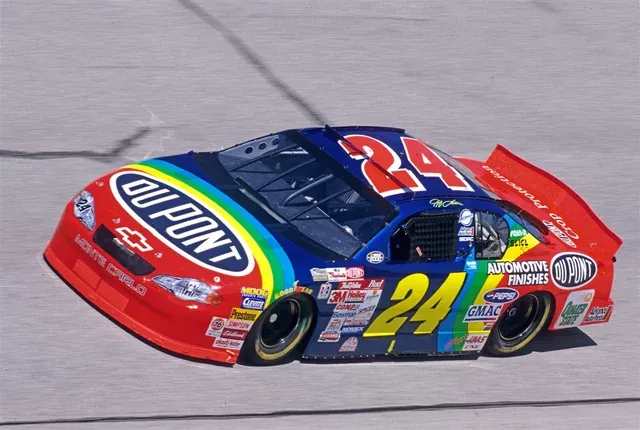

The NASCAR playoffs have always sparked debate, and a recent Dale Jr. Download episode with Dale Earnhardt Jr. and Chase Briscoe lit the fuse again. The duo dove into the original 10-race Chase format from 2004, giving props to its drama but wishing it could blend the best of that era with today’s setup.
Watch What’s Trending Now!
One thing the modern system gets right is seeding, unlike the clunky early days. From 2004 to 2006, the Chase seeded drivers purely on regular-season standings, which didn’t always reward winners. Then, from 2007 to 2013, it flipped to wins only, which ignored consistency. Both had holes.
Today’s format strikes a better balance, mixing regular-season points with wins to set the playoff field, giving guys like Martin Truex Jr. in 2017 a deserved edge for crushing it all year. Looking back through that lens flips some iconic title fights.
ADVERTISEMENT
Take 2004, the Chase’s debut year. Kurt Busch snagged the championship with steady runs in the final 10 races, but Jeff Gordon, Jimmie Johnson, and Dale Earnhardt Jr. had stronger cases. Gordon led most of the season with five wins, Johnson banked eight (including four in the last six races), and Earnhardt Jr. had six.
Busch’s consistency won under the rules, but today’s seeding, valuing both points and victories, might have crowned someone else. Fast forward to 2010, when Jimmie Johnson nabbed his fifth straight title. Kevin Harvick owned the regular season, topping the standings for 20 of 26 races with 26 top-10s. The Chase’s reset erased that edge, letting Johnson sneak through.
If today’s hybrid seeding had applied, Harvick’s dominance would have been tougher to overcome, maybe stopping Johnson’s streak. Then there’s 2007, Jeff Gordon’s monster year: six wins, 30 top-10s, and a 7.3 average finish, one of the best seasons ever.
ADVERTISEMENT
Yet, the wins-based reset handed Johnson the title with 10 victories. A modern system would have given Gordon a cushion for his consistency, maybe flipping the outcome. These “what ifs” show why Earnhardt Jr. and Briscoe’s idea hits home. A 10-race Chase with today’s seeding could have blended high-stakes drama with season-long merit.
The old format’s full reset or wins-only focus often shafted deserving drivers, and had NASCAR nailed a hybrid sooner, the Chase might not have needed so many tweaks. Fans are now piling on, digging up the format’s flaws and venting on Reddit about how it has shaped history and what could make it better.
ADVERTISEMENT
Fans call out the Chase’s flaws
Reddit’s been a hotbed for fans tearing into the Chase format’s issues. One nailed it, writing, “The original Chase, plus the two wild card was the best. The problem was the schedule was stale as hell. Had they rotated tracks in and out of the schedule more, we’re looking at playoff perfection! Season-long was fine too, had they gone with a point system that was different from the Latford one. Winning should’ve always meant more.”
The wild card era (2011–2013) gave underdogs like Martin Truex Jr. or Ryan Newman a shot via wins, despite the “Spingate” mess in 2013 showing its cracks. Fans also griped about the same old tracks, with Homestead always closing and no variety. Today’s mix of road courses and superspeedways feels fresher. The Latford system’s flaw, where Matt Kenseth’s single 2003 win clinched a title, proves why fans wanted wins to matter more.
ADVERTISEMENT
Another fan cut deep: “The primary problem people had with it was that of the 10 that happened, one guy won six of them.” That’s Jimmie Johnson’s reign — six titles, including five straight from 2006 to 2010. His No. 48 Hendrick machine dominated, but it made the Chase feel predictable, fueling calls for change like the 2011 wild card or 2014 eliminations. Fans wanted a format that didn’t let one driver run away with it.
One post echoed Gordon’s 2007 pain: “I agree with you OP. To og chase was way too much a full bore reset that didn’t reward a dominant regular season. Think 2007 with Jeff Gordon. If the seeding is done correctly, the regular season champ should easily have enough points that they effectively get a ‘mulligan’ if they have a bad race.” Gordon’s 30 top-10s and 7.3 average finish were unreal, but Johnson’s 10 wins stole the crown. Today’s playoff points would have given Gordon a buffer, balancing his season-long brilliance.
A creative take offered a fix: “It was (and is) too long relative to the regular season. Six races would have brought it in line with percentages from MLB, NFL, NBA. Then you do short track, mile, plate, road, and two 1.5s, the last one being at Charlotte to finish the season at home. Added bonus you can take the confetti’d champion car to the HOF just like the Daytona 500 winning car for the museum there.”
ADVERTISEMENT
A six-race playoff covering Martinsville, Kansas, Talladega, Watkins Glen, Darlington, and Charlotte would hit every track type and align with other sports’ shorter postseasons. Ending at Charlotte with a Hall of Fame display? Pure NASCAR flair.
Finally, a fan slammed the current system: “The win-and-in aspect is why this system sucks. Ten bonus points for wins like the old days is more than enough incentive. Lap led bonus, most laps led, fastest lap, stage points, win bonus points, all help to create a points system that rewards performance and consistency.”
The 2014 “win-and-in” rule led to oddities like Bubba Wallace making the 2023 playoffs without a win, while Austin Dillon missed out in 2022 despite one. The old 10-point bonus for wins, seen in Tony Stewart’s five-win 2011 title run, balanced aggression and consistency better, fans argue. With reset talks swirling, the Chase’s ghosts are alive and well.
ADVERTISEMENT
ADVERTISEMENT
ADVERTISEMENT
ADVERTISEMENT

